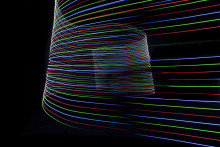Boller wants to bust a few myths about photonics, especially now that the technology, which focuses on the interaction between photons and electrons, is starting to gain traction in mainstream media. ‘No, photonic chips will never replace the electronic chips in your laptop or smartphone. They are simply too big for that. You cannot use optical chips in electronic equipment on a nanoscale.’
Drilling holes
Photonics is not the answer to everything, and that includes Moore’s Law. The professor is adamant about that. However, as his story goes on, it becomes increasingly clear that the technology has the potential to turn much of our world upside down. Boller is quick to put that impact into the right perspective, because it is an enabling technology: ‘The technology in itself is completely worthless. Compare it to drilling holes. That has no use, except making cavities. Its strength lies in what it facilitates. That is what makes it such a wonderful enabling technology.’
Where is photonics having such a major impact then, if not in our household equipment? ‘The key property of light is its speed,’ Boller answers. ‘It is the carrier of all information that can be described with a large quantity of more detailed information. To give an example: the large data stream from computers must ultimately be collected and transmitted via, for example, a fibreglass network. In that sense, electronics is practically a relic of the past. The people at my phone network back home in Germany must be beating themselves up because the cable network they put in the ground twenty years ago consists of copper cables. It is simply too slow to meet our future data needs.’
Blank page
Boller predicts that photonics will play a major role in meeting our growing data needs. If we want to transition to a 5G mobile network, the use of this photonic technology is essential. ‘It will play a role in the timing and rhythms between mobile phones and cell towers. The microwaves are translated using optical tricks on chips,’ Boller says. ‘At the moment, the signal is sent out in a wide radius and only a small part is picked up by cell phones. The goal is to facilitate direct communication between a phone and the antenna on a cell tower. That is where the optics are found: the antenna will consist of a photonics-controlled arrangement of antennas, a so-called antenna array. If everything works well, the data stream can be sped up by a factor of a thousand.’
Photonics can not only improve our mobile networks. Boller believes the biggest challenge associated with the underground fibreglass network is pushing as much data as possible through the optical cables. ‘That is certainly possible, up to a factor of a hundred or more, as long as you use the right modulation techniques and extremely phase stabile lasers,’ Boller says. ‘Look at it as a piece of paper that you want to write as much information as possible on. If it is already covered in writing, there is less available space and the final result will be hard to understand. However, if you use a blank page, you can write down more information in a clearer and more efficient manner. The same principle applies to data streams that you write on laser light,’ the professor explains.
‘Twente is a global leader in clean-frequency laser chips.’
Leader
He has more examples. ‘Take Google’s data centres. They are so large that the distance between two microchips can easily be two kilometres. It is important to cover that distance as quickly and with as much data as possible.’ However, Boller knows that optics is about accuracy as much as speed. ‘Think of optical sensors. After all, glass fibres are nothing more than sensor heads. Autonomous traffic will be based on optical sensing to carefully measure the vehicles’ relative positions.’ Boller also mentions sensors in buildings, airplane wings, oil sources, endoscopes… Without doubt, every one of these applications can benefit from the enabling technology that is photonics.
Boller rightfully concludes that Twente – like Eindhoven – is one of the world’s hubs when it comes to this innovative technology. Whereas the people in Eindhoven mainly excel at manufacturing semiconductors, Twente is a global leader in clean-frequency laser chips. ‘It is the result of forty years of relatively unrestricted work,’ Boller says. ‘A lead like that is hard to overcome, especially in a world where the saying that 'the winner takes it all' is increasingly true. This first move we made has given us a major advantage.’
This article appeared in the latest edition of the U-Today Science & Technology Magazine.







